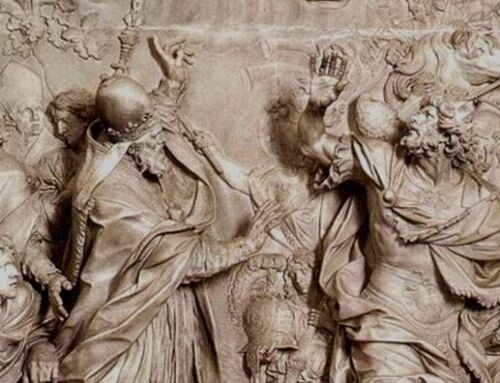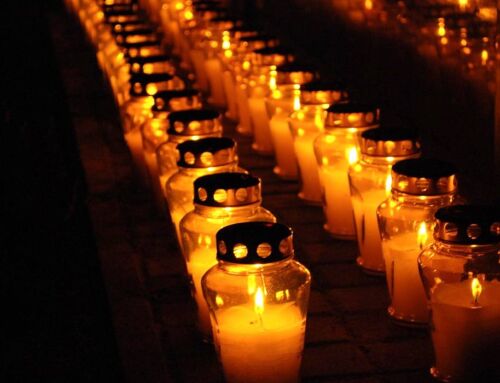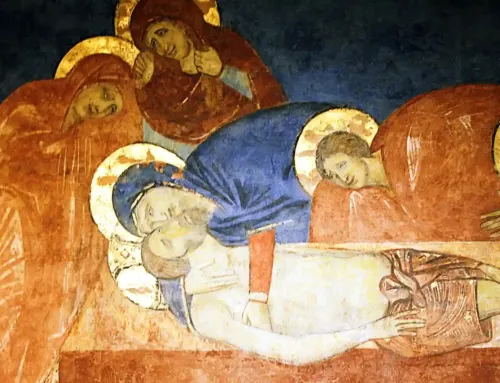Someone once posed the question: If the Lord said, “Unless you eat the flesh of the Son of Man and drink his blood, you do not have life within you” (Jn 6:53), then why do we use bread for the Eucharist instead of meat? Isn’t meat a better symbol of “flesh”?
It’s an intelligent question, but the answer to it goes beyond the literal meaning of “flesh”: Yes, meat is a better symbol of flesh, but it is not a better symbol of the divine life that comes to us in the Eucharist.
 Bread is the most basic staple of existence. It has been so since man learned to farm. It is not the only staple food, but it is undoubtedly the universal symbol of food for the human race, available in some form to sustain bodily life in every culture and epoch of human history.
Bread is the most basic staple of existence. It has been so since man learned to farm. It is not the only staple food, but it is undoubtedly the universal symbol of food for the human race, available in some form to sustain bodily life in every culture and epoch of human history.
And that’s why the Lord also made it the primordial sustenance for spiritual life.
Symbolism vs Reality
The Blessed Sacrament of the Church has symbolic aspects to it (for example, the altar symbolizes a table for eating a meal; red wine has the appearance of blood, etc.), but the Eucharist itself is not a symbol.
It is real. The Lord said, “My body is real food and my blood is real drink” (Jn 6:55). In fact, it is the ultimate reality because it is Jesus Himself who sustains us. He is Life.
But we can imagine that something so fundamental to the human spirit was not just sprung on us as a surprise at some time in history. It was given to us after centuries of preparation. Most of us who read the Bible or hear the readings at Church will know these stories, which all come from the history of God’s Chosen People.
Three Preparations
That is the clearest sign of our sacrament, but I’d like to focus here on three other signs of Eucharistic bread that come to us from the story of the Hebrew nation.  They are, chronologically,
They are, chronologically,
- The unleavened bread of Passover
- The manna in the desert, and
- The showbread in the Temple (sometimes called the Bread of the Presence)
Unleavened Bread
The Israelites ate unleavened bread on the night before they left Egypt because in their haste they didn’t have time to prepare bread with yeast. They ate this bread with staff in hand, ready to travel. It was described by the Lord as the “bread of affliction” (Dt 16:3), literally the bread of slaves.
The innate symbolism (“haste” and “affliction”) of this bread has been kept alive through the Passover ritual that the Jews celebrate to this day and of which the Eucharist is the direct descendant and fulfillment. It represents not only the sorrow of slavery, but the memory of God freeing them from slavery.
Jesus celebrated the Last Supper on the Feast of Unleavened Bread on Holy Thursday night. As we know, it was the scene of the very institution of the sacrament of the New Covenant in His Blood, the Eucharist.
Manna
The manna in the desert (Ex 16:1-36) was overtly a life-sustaining gift of God that kept His people alive in the desert when they were in danger of starving. But it was also an ongoing miracle.
 Think about it. The lowest estimate of Israelites to leave Egypt in the Exodus was about 20,000 (but the census data in the Book of Numbers indicates that it could have been over two million). Let’s take the lower number at face value.
Think about it. The lowest estimate of Israelites to leave Egypt in the Exodus was about 20,000 (but the census data in the Book of Numbers indicates that it could have been over two million). Let’s take the lower number at face value.
To feed 20,000 people for even one meal would have required a trainload or more of bread. Yet, flakes of manna rained down from the sky for six days a week, not just for one week, but for forty years—and at any place they went in their wanderings.
It’s impossible to imagine the logistical nightmare of getting that much food to that many people for that long of a time. (And don’t forget, their animals had to eat too!) Humanly speaking, it was an impossibility. But it was not difficult for God.
The sign value of the manna was also clear: later scriptural writers described the manna as “bread from heaven” and “the food of angels” (Neh 9:15; Ps 105:40; 78:24-25; Wis 16:20-21) to emphasize the divine nature of the gift.
Such a gift prepared us for the other ongoing miracle of changing bread and wine into the Body and Blood of Christ that happens each time we celebrate the Eucharist.
Bread of the Presence
This bread is one of the most obscure institutions of Scripture but also one of the richest of Eucharistic symbols. What we translate into English as “showbread” was called “Bread of the Faces” in the original Hebrew (see Ex 25 and Lev 24).
 It simply meant “bread that was placed before the face of God,” although in the plural form, “faces” expands to mean “in the presence of”. It consisted of twelve cakes baked from fine flour and arranged in two rows on a table in the outer sanctuary and was replaced once a week.
It simply meant “bread that was placed before the face of God,” although in the plural form, “faces” expands to mean “in the presence of”. It consisted of twelve cakes baked from fine flour and arranged in two rows on a table in the outer sanctuary and was replaced once a week.
It was this bread that David and his men ate in 1 Samuel 21 when it was given to them by the priest. The warriors assured the priest that they were ritually pure (abstinent) before they ate it. Jesus even referred to this incident when speaking of the Sabbath (Mt 12:3-8).
This bread adds layers of meaning to the Eucharistic symbolism: it was bread of the Temple, before the divine Presence, displayed in the sanctuary on an altar-type table, ministered to by priests, and eaten only by those who were ritually pure.
A Trinity of Symbols
We can see, then, how the Lord prepared His Church with a “trinity” of breads that became signs of the reality to come:
 Like the manna in the desert, the Eucharist sustains the Church and us on our pilgrimage through life and in our spiritual trials—miraculously.
Like the manna in the desert, the Eucharist sustains the Church and us on our pilgrimage through life and in our spiritual trials—miraculously.- Like the showbread, the Eucharist is for the temple of worship but it is more—it is Christ’s sacrifice of Calvary re-presented sacramentally on an altar, offered by priests, and requiring of us a purity of heart and a warrior spirit to receive Him.
- Like the unleavened bread of affliction at Passover, the Eucharist is the New Covenant of His Body and Blood, which is our liberation from the tyranny of sin. Like the Israelites, we also “do this in remembrance” of our Lord’s mercy.
Now perhaps it becomes clear why we don’t offer meat for the Eucharistic sacrifice. It is not the physical flesh of our Lord that we offer sacramentally on the altar; it is the Body and Blood, Soul and Divinity of Jesus Christ Himself under the appearance of bread and wine. It is the greatest force of life known to man.
One final point that isn’t a small point in this discussion: the Hebrew word for bread is lehem. Jesus was born in Bethlehem, which means “house of bread”. So the One who gives us Himself under the form of bread comes from the house of bread. Coincidence?
The Solemnity of Corpus Christi
Since the year 1264 AD Catholics have celebrated the feast of the Body and Blood of Our Lord as a universal feast of the Church.
It was one of those phenomena that sprang out of the devotional life of the Church like so many springs of water that merged and became a mighty river. Three other amazing “coincidences” of that time brought about the feast we celebrate today:
- St. Juliana of Liège (Belgium) became the primary proponent of this feast when she received a vision of Christ who showed her a sign that one important feast was missing from the Church calendar. She was chosen to promote it. She labored for twenty years to foster this devotion in her local church.
- Six years after her death, an Archdeacon of her diocese was elected Pope Urban IV, who then established the feast of Corpus Christi for the universal Church.
- The Church’s greatest theologian, St. Thomas Aquinas, was in his prime in that very era, and the pope asked him to compose the prayers and hymns of the feastday. When we sing “O Salutaris Hostia” or “Tantum Ergo”, we are singing St. Thomas’ own words.
So it seems that the Lord not only prepared for the Eucharist by way of Old Testament signs, but He also prepared for the most wonderful feast of the Eucharist by making sure all the right saints were in the right places!

Previous SW Articles on the Eucharist
Thomas Aquinas’ Eucharistic Heart and Hymn
Humility and Life in Aquinas’ Famous Hymn
“O Sacrament most holy, O Sacrament divine
All praise and all thanksgiving be every moment Thine!”
These beautiful lines come from a hymn that was composed sometime in the late 1800s. No one can identify the original author. But in a way, that is fitting. It’s the Church’s own cry of love for her Eucharistic Lord and a lovely hymn for the Feast of Corpus Christi.
Because it is an organic musical expression in the life of the Church, the verses vary from place to place. However these four verses of the simple but exquisite hymn are standard, and the tune may sound familiar to you when you watch the videos below.
Have a blessed feast of the Body and Blood of our Lord Jesus Christ!
1 O Lord, I am not worthy
That thou should’st come to me;
But speak the word of comfort,
My spirit healed shall be.
2 And humbly I’ll receive thee,
The Bridegroom of my soul,
No more by sin to grieve thee
Or fly thy sweet control.
3 Eternal Holy Spirit,
Unworthy though I be,
Prepare me to receive him
And trust the Word to me.
4 Increase my faith, dear Jesus,
In thy real presence here,
And make me feel most deeply
That thou to me art near.
Robert Shaw Chorale (2:25)
Singing Nuns (3:01)
———-
[Note: This article is a reproduction of the Sacred Windows Email Newsletter of 6/02/24. Please visit our Newsletter Archives.]
Photo Credits: via Wikimedia: Showbread (Mboesch); Nuns (Angelo Graf Von Courten, public domain); all other images via Pixabay.






OH ¡¡¡ I AM SO HAPPY GOING THROUGH THE STUDY OF BLOOD AND WINE ¡¡¡ PLEASE EXPLAIN JESUS TOLD IN THE GOSPEL OF MARK 14 : 25 ???